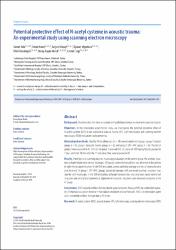Potential protective effect of N-acetyl cysteine in acoustic trauma: An experimental study using scanning electron microscopy

View/
Access
info:eu-repo/semantics/openAccessDate
2017Author
Ada, ServetHanci, Deniz
Ulusoy, Seçkin
Vejselova, Djanan
Burukoğlu, Dilek
Muluk, Nuray Bayar
Cingi, Cemal
Metadata
Show full item recordAbstract
Background. Oxidative stress has been associated with pathological processes involved in acoustic trauma. Objectives. In this prospective experimental study, we investigated the potential preventive effect of N-acetyl cysteine (NAC) in rats exposed to acoustic trauma (AT). Light microscopic and scanning electron microscopic (SEM) evaluations were performed. Material and methods. Healthy Wistar albino rats (n = 18) were divided into 3 groups: group 1 (control group, n = 6), group 2 (acoustic trauma group, n = 6), and group 3 (AT+NAC group, n = 6). The rats in group 2 were exposed to AT. The rats in group 3 received NAC at a dose of 100 mg/kg/day by gavage for 7 days, and then 10 min after the 7th-day dose, they were exposed to AT. Results. From light and scanning electron microscopy evaluations in the control group, the cochlear structure and epithelium were normal. In group 2 (AT group), extensive hair cell loss was observed in the cochlea by light microscopy evaluation. In the SEM evaluation, various epithelial damage and loss of stereocilia were also observed. In group 3 (AT+ NAC group), decreased damage with preserved cochlear structures was seen by light microscopy. In the SEM evaluation, although stereocilia loss was also seen, nearly normal cell structures and vertical and symmetrical alignment of stereocilia structures were observed compared to the AT group. Conclusions. NAC reduced cochlear damage due to acoustic trauma. Because NAC has antioxidant capacity, AT mat have caused an increase in free radicals and death of outer hair cells. NAC is an antioxidant agent and it prevented cochlear damage due to AT in rats.

















